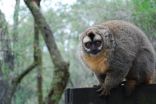(Press-News.org) VERNON -- Dr. Dariusz Malinowski is seeing blue, and he is very excited.
For four years, Malinowski, an AgriLife Research plant physiologist and forage agronomist in Vernon, has been working with collaborators Steve Brown of the Texas Foundation Seed and Dr. William Pinchak and Shane Martin with AgriLife Research on a winter-hardy hibiscus breeding project.
The project was first a private hobby of the inventors and became a part of the strategic plan of the Texas AgriLife Research and Extension Center at Vernon in 2009. The flower commercialization is a part of the research on non-traditional or under-utilized crops that have value because of drought tolerance.
Malinowski's breeding goal has been to create a blue-flowering winter-hardy hibiscus.
"A blue pigment does not exist in this species, thus hybridizers have not been successful so far in creating a plant with blue flowers," he said. "There are a couple of recently introduced cultivars with plum and lavender flower color."
But now Malinowski has managed to breed a flower with the illusive color.
He and his collaborators have created a number of lines with unique flower and foliage shape and color. The new hibiscus hybrids range in color from white through different shades of pink, lavender, bluish, red and magenta tones, and some of them have combinations of two or even three colors.
One line has dark maroon foliage with moderately big, white flowers that blend into a pink center with darker veins, Malinowski said. Flower size of these hybrids varies from miniature blooms 2 inches in diameter to the size of dinner plates, about 12 inches in diameter.
Malinowski has been using these cultivars in his breeding project for several generations. This year, they finally had one plant bloom with almost blue flowers, a significant breakthrough in efforts to create a blue hibiscus cultivar.
"It took four years of work and more than 1,000 crosses among three winter-hardy hibiscus species to achieve this goal of creating an almost-blue flowering hibiscus hybrid," he said.
The new hybrid is not perfect yet, Malinowski said.
"The flowers get a fantastic blue hue in shade, but in full sunlight they are still plum-lavender-bluish," he said.
Brown said it is important to note that in the world of ornamentals, "blue" is interpreted to have a wide range of hues. Most ornamental blues have a more purple or lavender cast.
"There are very few true blue flowers in any ornamental cultivar," he said. "Although I would call this flower 'almost blue' as Dariusz has, there is no question that this development is unique in known hardy hibiscus color ranges.
"My expectation is that we will see more vibrant colors in next year's F1s (cultivars) using this line as a parent," Brown said.
Malinowski said he will use this plant as a parent in his breeding project this summer, with the goal to stabilize the blue color in full sunlight and increase flower size from the current 7 inches to the "magic" 12-inch diameter.
Breeding of ornamental plants is not the major research area of Malinowski, but he said he enjoys new challenges and the benefits of combining his private hobby with business.
"I never thought I would be an expert in breeding winter-hardy hibiscus," he said. "The knowledge I have gained during the past few years of intensive work on hardy hibiscus helps me reach most of the breeding objectives in a relatively short time."
What is next? Malinowski and his collaborators have a new challenge - to create an orange flowering hardy hibiscus.
This goal seems to be even more difficult, but not impossible, Malinowski said. It will require hybridization with a distantly related hibiscus species, which has shades of orange flowers. The researchers hope that with the help of molecular genetic tools they will be able to meet this objective.
###
AgriLife research hibiscus breeder comes up with the blue
Rare hibiscus color is achieved after four years
2010-09-04
ELSE PRESS RELEASES FROM THIS DATE:
Queen's study exposes cognitive effects of Parkinson's disease
2010-09-04
Researchers at Queen's University have found that people with Parkinson's disease can perform automated tasks better than people without the disease, but have significant difficulty switching from easy to hard tasks. The findings are a step towards understanding the aspects of the illness that affect the brain's ability to function on a cognitive level.
"We often think of Parkinson's disease as being a disorder of motor function," says Douglas Munoz, director of the Queen's Centre for Neuroscience Studies and a Canada Research Chair in Neuroscience. "But the issue is ...
Increase in Cambodia's vultures gives hope to imperiled scavengers
2010-09-04
While vultures across Asia teeter on the brink of extinction, the vultures of Cambodia are increasing in number, providing a beacon of hope for these threatened scavengers, according to the Wildlife Conservation Society (WCS) and other members of the Cambodia Vulture Conservation Project.
Researchers report that record numbers of vultures have been counted in Cambodia's annual vulture census, with 296 birds of three species found at multiple sites across the Northern and Eastern Plains of Cambodia by the Cambodia Vulture Conservation Project, a partnership of conservationists ...
Afla-Guard also protects corn crops
2010-09-04
Afla-Guard®, a biological control used to thwart the growth of fungi on peanuts, can be used on corn as well, according to a study by U.S. Department of Agriculture (USDA) scientists who helped develop it.
After extensive study and research trials in Texas, Afla-Guard® was registered by the U.S. Environmental Protection Agency (EPA) for use on corn, beginning with the 2009 crop.
Recently retired Agricultural Research Service (ARS) microbiologist Joe Dorner at the National Peanut Research Laboratory in Dawson, Ga., helped develop Afla-Guard®, a biological control for ...
Magnetism's subatomic roots
2010-09-04
The modern world -- with its ubiquitous electronic devices and electrical power -- can trace its lineage directly to the discovery, less than two centuries ago, of the link between electricity and magnetism. But while engineers have harnessed electromagnetic forces on a global scale, physicists still struggle to describe the dance between electrons that creates magnetic fields.
Two theoretical physicists from Rice University are reporting initial success in that area in a new paper in the Proceedings of the National Academy of Sciences. Their new conceptual model, which ...
MIT moves toward greener chemistry
2010-09-04
CAMBRIDGE, Mass. - Phosphorus, a mineral element found in rocks and bone, is a critical ingredient in fertilizers, pesticides, detergents and other industrial and household chemicals. Once phosphorus is mined from rocks, getting it into these products is hazardous and expensive, and chemists have been trying to streamline the process for decades.
MIT chemistry professor Christopher Cummins and one of his graduate students, Daniel Tofan, have developed a new way to attach phosphorus to organic compounds by first splitting the phosphorus with ultraviolet light. Their method, ...
Moonstruck primates: Owl monkeys need moonlight as much as a biological clock for nocturnal activity
2010-09-04
PHILADELPHIA –- An international collaboration led by a University of Pennsylvania anthropologist has shown that environmental factors, like temperature and light, play as much of a role in the activity of traditionally nocturnal monkeys as the circadian rhythm that regulates periods of sleep and wakefulness.
The study also indicates that when the senses relay information on these environmental factors, it can influence daily activity and, in the case of a particular monkey species, may have even produced evolutionary change. It is possible, according to the study results, ...
NASA imagery reveals a weaker, stretched out Fiona
2010-09-04
NASA satellite data has noticed that Tropical Storm Fiona is getting "longer." That is, the storm is elongating in almost a north-south direction, indicating that she's weakening and may not make it through the weekend. Meanwhile, forecasters are watching two other areas for development in the eastern Atlantic this weekend.
The Geostationary Operational Environmental Satellite, GOES-13 captured an image of Fiona on Friday, Sept. 3 at 10:32 a.m. EDT and the visible image showed a weak circulation in Fiona's center. It also appeared that Fiona's clouds were "stretched" ...
NASA satellite and International Space Station catch Earl weakening
2010-09-04
NASA satellites and the International Space Station are keeping eyes on Hurricane Earl as it heads for New England. Watches and Warnings are posted in the U.S. northeast.
Having felt the effects of both increasing wind shear and cooler waters, Hurricane Earl weakened to a Category 2 storm on the Saffir-Simpson scale with winds still powerful at 90 knots (104 mph) as it neared the North Carolina coast. It was at this time that the Tropical Rainfall Measuring Mission (TRMM) satellite captured the data about TRMM's rainfall rates.
The rainfall pattern associated with ...
Transition metal catalysts could be key to origin of life, scientists report
2010-09-04
MBL, WOODS HOLE, MA—One of the big, unsolved problems in explaining how life arose on Earth is a chicken-and-egg paradox: How could the basic biochemicals—such as amino acids and nucleotides—have arisen before the biological catalysts (proteins or ribozymes) existed to carry out their formation?
In a paper appearing in the current issue of The Biological Bulletin, scientists propose that a third type of catalyst could have jumpstarted metabolism and life itself, deep in hydrothermal ocean vents.
According to the scientists' model, which is experimentally testable, molecular ...
For some women, preventive mastectomies pay off
2010-09-04
SAN ANTONIO, TX (Sept. 3) — A long-term study of women with a genetic predisposition for breast or ovarian cancer showed that those who elected major preventive surgeries had a significantly reduced risk of those cancers.
The study, published Sept. 1 in the Journal of the American Medical Association, confirms the view of one of its researchers, Gail Tomlinson, M.D., Ph.D., interim director of the Greehey Children's Cancer Research Institute at The University of Texas Health Science Center at San Antonio.
Dr. Tomlinson said that for women with certain genetic mutations, ...
LAST 30 PRESS RELEASES:
Data-driven analysis reveals three archetypes of armed conflicts
Heart disease, stroke deaths down, yet still kill more in US than any other cause
Light switches made of ultra-thin semiconductor layers
Creative talent: has AI knocked humans out?
Sculpting complex, 3D nanostructures with a focused ion beam
A year after undermining Bredt’s rule, UCLA scientists have made cage-shaped, double-bonded molecules that defy expectations
Human activities drive global dryland greening
PeroCycle announces new appointments as it builds a world-class board for meaningful climate impact
Magnetic avalanches power solar flares
LeapSpace goes live: the Research-Grade AI-Assisted Workspace built on trusted science
DNA tests reveal mysterious beluga family trees
Strategic sex: Alaska’s beluga whales swap mates for long-term survival
How early cell membranes may have shaped the origins of life
Cannabis legalization is driving increases in marijuana use among U.S. adults with historically lower consumption rates
Multifunctional dipoles enabling enhanced ionic and electronic transport for high‑energy batteries
Triboelectric nanogenerators for future space missions
Advancing energy development with MBene: Chemical mechanism, AI, and applications in energy storage and harvesting
Heteroatom‑coordinated Fe–N4 catalysts for enhanced oxygen reduction in alkaline seawater zinc‑air batteries
Meta-device for precision lateral displacement sensing
Plasma-guided mitotane for the treatment of adrenocortical carcinoma: adjuvant care to advanced disease
Theoretical study of laser-enhanced nuclear fusion reactions
Social environment impacts sleep quality
Optimized kinetic pathways of active hydrogen generation at Cu2O/Cu heterojunction interfaces to enhance nitrate electroreduction to ammonia
New design playbook could unlock next generation high energy lithium ion batteries
Drones reveal how feral horse units keep boundaries
New AI tool removes bottleneck in animal movement analysis
Bubble netting knowledge spread by immigrant humpback whales
Discovery of bats remarkable navigation strategy revealed in new study
Urban tributaries identified as major sources of plastic chemical pollution in the Yangtze River
UK glaucoma cases higher than expected and projected to reach 1.6 million+ by 2060
[Press-News.org] AgriLife research hibiscus breeder comes up with the blueRare hibiscus color is achieved after four years




